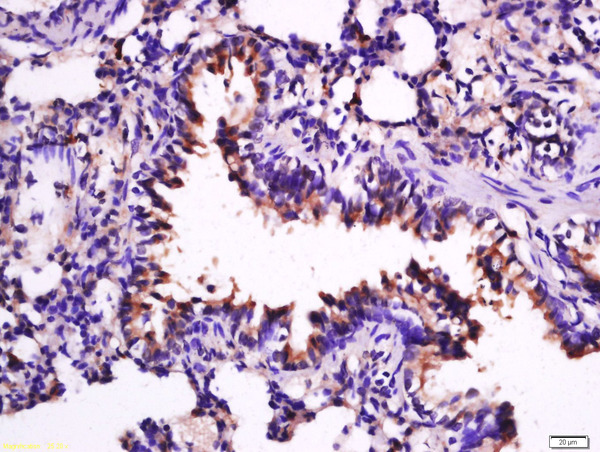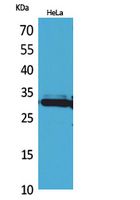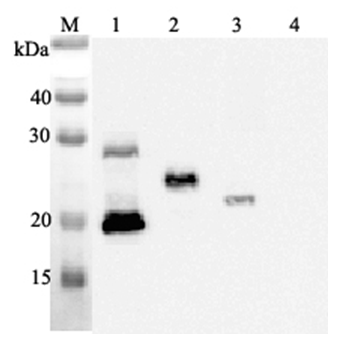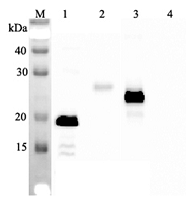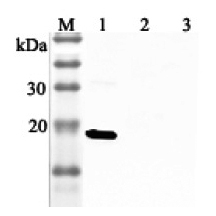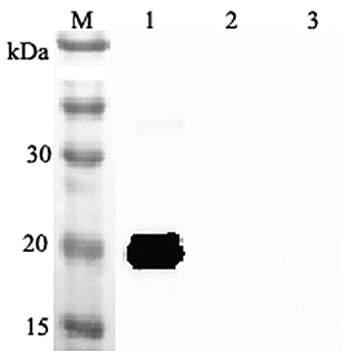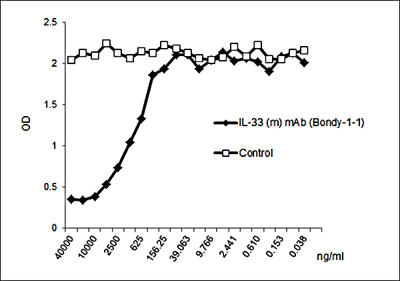
anti-IL-33 (mouse), mAb (rec.) (Carly-1-4)
AG-27B-0012
ApplicationsWestern Blot, ELISA
Product group Antibodies
TargetIl33
Overview
- SupplierAdipoGen Life Sciences
- Product Nameanti-IL-33 (mouse), mAb (rec.) (Carly-1-4)
- Delivery Days Customer10
- ApplicationsWestern Blot, ELISA
- CertificationResearch Use Only
- ClonalityMonoclonal
- Clone IDCarly-1-4
- Concentration1 mg/ml
- Estimated Purity>95%
- Gene ID77125
- Target nameIl33
- Target descriptioninterleukin 33
- Target synonyms9230117N10Rik, Il-33, Il1f11, NF-HEV, interleukin-33, nuclear factor from high endothelial venules
- HostHuman
- IsotypeIgG2
- Protein IDQ8BVZ5
- Protein NameInterleukin-33
- Scientific DescriptionInterleukin-33 (IL-33; HF-NEV; IL-1F11), a member of the IL-1 family of cytokines, is expressed by many cell types following pro-inflammatory stimulation and is thought to be released upon cell lysis. IL-33 binds to and signals through ST2 (IL-1R1) and its stimulation recruits MYD88, IRAK, IRAK4 and TRAF6, followed by phosphorylation of ERK1 (MAPK3)/ERK2 (MAPK1), p38 (MAPK14) and JNK. The ability of IL-33 to target numerous immune cell types, like Th2-like cells, mast cells and B1 cells, and to induce cytokine and chemokine production underlines its potential in influencing the outcome of a wide range of diseases, such as arthritis, asthma, atopic allergy & anaphylaxis, cardiovascular disease/atherosclerosis, nervous system diseases and sepsis. Anti-IL-33, mAb (recombinant) (Carly-1-4) is an antibody developed by antibody phage display technology using a human naive antibody gene library. These libraries consist of scFv (single chain fragment variable) composed of VH (variable domain of the human immunoglobulin heavy chain) and VL (variable domain of the human immunoglobulin light chain) connected by a polypeptide linker. The antibody fragments are displayed on the surface of filamentous bacteriophage (M13). This scFv was selected by affinity selection on antigen in a process termed panning. Multiple rounds of panning are performed to enrich for antigen-specific scFv-phage. Monoclonal antibodies are subsequently identified by screening after each round of selection. The selected monoclonal scFv is cloned into an appropriate vector containing a Fc portion of interest and then produced in mammalian cells to generate an IgG like scFv-Fc fusion protein. - Recombinant Antibody. Recognizes mouse IL-33. Species cross-reactivity: Mouse. Clone: Carly-1-4. Isotype: Human IgG2lambda. Applications: ELISA, WB. Host: Purified from HEK 293 cell culture supernatant. Liquid. In PBS containing 10% glycerol and 0.02% sodium azide. Interleukin-33 (IL-33; HF-NEV; IL-1F11), a member of the IL-1 family of cytokines, is expressed by many cell types following pro-inflammatory stimulation and is thought to be released upon cell lysis. IL-33 binds to and signals through ST2 (IL-1R1) and its stimulation recruits MYD88, IRAK, IRAK4 and TRAF6, followed by phosphorylation of ERK1 (MAPK3)/ERK2 (MAPK1), p38 (MAPK14) and JNK. The ability of IL-33 to target numerous immune cell types, like Th2-like cells, mast cells and B1 cells, and to induce cytokine and chemokine production underlines its potential in influencing the outcome of a wide range of diseases, such as arthritis, asthma, atopic allergy & anaphylaxis, cardiovascular disease/atherosclerosis, nervous system diseases and sepsis. Anti-IL-33, mAb (recombinant) (Carly-1-4) is an antibody developed by antibody phage display technology using a human naive antibody gene library. These libraries consist of scFv (single chain fragment variable) composed of VH (variable domain of the human immunoglobulin heavy chain) and VL (variable domain of the human immunoglobulin light chain) connected by a polypeptide linker. The antibody fragments are displayed on the surface of filamentous bacteriophage (M13). This scFv was selected by affinity selection on antigen in a process termed panning. Multiple rounds of panning are performed to enrich for antigen-specific scFv-phage. Monoclonal antibodies are subsequently identified by screening after each round of selection. The selected monoclonal scFv is cloned into an appropriate vector containing a Fc portion of interest and then produced in mammalian cells to generate an IgG like scFv-Fc fusion protein.
- Storage Instruction-20°C,2°C to 8°C
- UNSPSC12352203

